— Miami woman leading the call has new hope

By Lauren Costantino
For more than a decade, Ellie Hidalgo has been campaigning to expand the role of women in the Catholic Church.
The Miami woman is co-director of a nonprofit, Discerning Deacons, which invites other Catholics to consider ordaining women as deacons — a clergy role that has already been opened to married men. That would allow women for the first time in centuries to preach the Gospel, preside at baptisms, direct charitable services and perform other duties long confined to males.
From her past work, she knows the value women can add to the church. As a pastoral associate at a Jesuit parish near downtown Los Angeles, she worked with immigrant women from Mexico and Central America. In times of need, Hidalgo, who is trained in pastoral theology and fluent in Spanish, was called on to preach, assisting a priest who had trouble communicating with congregants. She’s also met with Catholic indigenous women in the Amazon region of Brazil who are on the front lines of defending human and land rights.
Hildago, who now attends Our Lady of the Divine Providence in Sweetwater, knows her devout Cuban grandmothers would never question why only men could serve pastoral roles. But that’s definitely not the case in conversations with her own nieces — they want to hear someone with “their own lived experience, from somebody who’s a sister or a daughter or a mother.“
Now, for the first time in years, Hidalgo can envision a day when the church might actually open some leadership doors to women.
Her hope springs from attending the Synod of Bishops, a monthlong assembly of church leaders in Rome that can shape future policy for the Catholic Church. The question of involving women in church leadership was widely discussed during the October gatherings, with a culminating report sending favorable signals for lifting some gender barriers in the future.
Although no concrete decisions were made this year, the tenor of discussions encouraged Hildago and others who share her goal for a more inclusive church. On the issue of ordaining women as deacons, the report called for continued research and discussion to be taken up at next year’s session.
“We were very pleased that that made it in there,” Hidalgo said. “It’s a very big step forward.”
The synod included 480 members appointed by Pope Francis from all continents. They participated in a process the church calls “conversations in the spirit.” It involved listening, praying and drawing up recommendations for the pope.
“What is the Holy Spirit asking of the church in the third millennium? What are the needs?” said Hidalgo. “In these times where we see a lot of profound woundedness in the world, more wars, and famine and drought and tons of migration — these were some of the topics that were being taken up. What is causing all that and how is the church to respond?”
Synod signals a possible shift
A synthesis report released by the pope appears to reflect a significant shift in centuries of resistance to putting women in leadership roles: “It is urgent to ensure that women can participate in decision-making processes and assume roles of responsibility in pastoral care and ministry.”
Along with considering making women deacons, other proposals called for the expansion of theological study and seminary programs to women. The report also said cases of labor injustice within the church need to be addressed, as women “are too often treated as cheap labour.” It also proposes expanding the responsibilities of a lector — someone who reads Scriptures during Mass — “to become a fuller ministry in the Word of God,” which in some contexts could include a woman preaching.
The role of women in the church has long been a divisive issue. But Miami Archbishop Thomas Wenski said that on many fronts, voting delegates agreed. Every paragraph included in the report must be approved by at least two-thirds of voting members — meaning the majority felt strongly about expanding women’s roles.
“There were many points of convergence – and so the Synod participants were not as divided as some looking in from the outside imagine,” Wenski wrote in an email to the Herald.
He said that many of the proposals involving women are already implemented in the United States.
“Our seminaries have women teaching on their faculties, some are involved in supervising seminarians in the pastoral assignments,” he said. “And they vote as other faculty members do … Our chanceries and our parishes do have women in roles of great responsibilities.”
The synod report also touched — often cautiously — on other lightning-rod issues, including immigration crises across the globe.
“In the face of increasingly hostile attitudes toward migrants, we are called to practice an open welcome, to accompany them in the construction of a new life and to build a true intercultural communion among peoples,” the report read.
There was a call to “to eradicate the sin of racism,” including within the church, though not much detail was given on how to do it.
And although there were discussions about LGBTQ people — Jesuit priest Father James Martin, for instance, was chosen as a synod delegate because of his commitment ministering LGBTQ Catholics — there were no official recommendations in the report.
Synod firsts for women
Still, the changes in this synod were significant. While past meetings consisted of solely bishops and cardinals, this year’s participants included priests, deacons, religious women and men, laymen and women and three young adults — the youngest was a 19-year-old student from the University of Wyoming. Out of the 363 voting members, 54 were women, a first in synod history.
“One of Pope Francis’ strong beliefs, and a belief of the synod process, is that the Holy Spirit can speak through anyone,” Hidalgo said. “We know that when Jesus chose his apostles, he didn’t go to the people you would expect. He went to fisherman.”
To ensure synod members heard each other’s perspectives, delegates were seated at round tables composed of clergy and lay people — a stark difference from the usual theater-style set-up more akin to lectures than discussions.
The changes reflected a papal mission to create a more unified church.
“Why do I insist on this?” Pope Francis said in 2021. “Because sometimes there can be a certain elitism … the priest ultimately becomes more a ‘landlord’ than a pastor of a whole community as it moves forward.”
Leading up to the assembly, millions of Catholics also participated in meetings at local parishes, praying together and discussing issues. It was the first time during a Synod of Bishops that everyone on all levels of the church was asked to participate.
In Miami’s listening sessions, people were concerned about declining membership, young people becoming less engaged in their faith and the lingering fallout of past clergy abuse scandals. Many wanted clearer answers on controversial issues that have divided the church.
There was positive feedback, too: the church providing a sense of belonging, admiration for priests dedicated to their mission and appreciation for the church’s ongoing commitment to charitable causes.
“Our own synodal process here locally has helped us look to the future with great hope,” Archbishop Wenski said. ‘”The Church in Miami is alive – we are concerned about many of the same issues that concerned the Synod members in Rome, but like them we acknowledge that God is in charge and we want to follow the Spirit’s lead.”
‘There is room for everyone’
Although Hidalgo was not a synod delegate, she traveled to Rome for associated public activities, spending a lot of time listening to the group of young adults who traveled with her organization.
“Young people I have listened to worry about their LGBTQ friends and family members, their divorced and remarried parents, the poor, migrants who face a hostile welcome, war-torn places, and our common home, the natural world,” she said. “They also want women to have more of a voice and to be at decision-making tables.”
At the opening Mass of the Synod in St. Peter’s Square in Vatican City, Hidalgo and the group of young adults donned T-shirts that read “En la iglesia hay lugar para todos!” It’s a reference to World Youth Day in Portugal when Pope Francis told the youth in Spanish, “In the Church there is room for everyone. Everyone, everyone, everyone.”
The words resonated with the 20-to 30-year-old Catholics, she said. They understand the struggles of those who feel like they don’t belong. In Rome, they listened to Pope Francis share this same message during his homily, this time in Italian.
“Come, you who are weary and oppressed, come, you who have lost your way or feel far away, come, you who have closed the doors to hope: the Church is here for you! The doors of the Church are open to everyone, everyone, everyone!”
Every Saturday night during the month-long synod, thousands of people gathered for a rosary prayer. The war between Israel and Hamas was top of mind for attendees, and the mood was somber, Hidalgo said. The bombing and mounting human deaths a reminder of the problems plaguing the world around them.
“We realized there’s so much at stake, not just for the church, but for the world. Our ability to figure out how to be peacemakers and how to resolve conflicts, and how to be able to dialogue about very difficult problems. Human lives are at stake.”
Complete Article ↪HERE↩!





